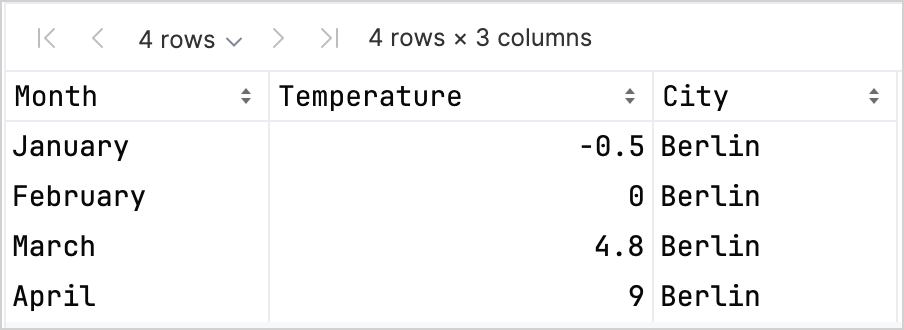Kandy를 이용한 Kotlin Notebook의 데이터 시각화
Kotlin은 강력하고 유연한 데이터 시각화를 위한 올인원 솔루션을 제공하여 복잡한 모델로 들어가기 전에 데이터를 제시하고 탐색할 수 있는 직관적인 방법을 제공합니다.
이 튜토리얼에서는 Kandy 및 Kotlin DataFrame 라이브러리와 함께 Kotlin Notebook을 사용하여 IntelliJ IDEA에서 다양한 차트 유형을 만드는 방법을 보여줍니다.
시작하기 전에
-
최신 버전의 IntelliJ IDEA Ultimate를 다운로드하여 설치합니다.
-
IntelliJ IDEA에 Kotlin Notebook plugin을 설치합니다.
또는 IntelliJ IDEA 내에서 Settings | Plugins | Marketplace에서 Kotlin Notebook plugin에 액세스합니다.
-
File | New | Kotlin Notebook을 선택하여 새 노트북을 만듭니다.
-
노트북에서 다음 명령을 실행하여 Kandy 및 Kotlin DataFrame 라이브러리를 가져옵니다.
%use kandy
%use dataframe
DataFrame 만들기
시각화할 레코드가 포함된 DataFrame을 만들어 시작합니다. 이 DataFrame은 세 도시(Berlin, Madrid, Caracas)의 월 평균 기온의 시뮬레이션된 숫자를 저장합니다.
Kotlin DataFrame 라이브러리의 dataFrameOf() 함수를 사용하여 DataFrame을 생성합니다. Kotlin Notebook에서 다음 코드 스니펫을 실행합니다.
// The months variable stores a list with the 12 months of the year
val months = listOf(
"January", "February",
"March", "April", "May",
"June", "July", "August",
"September", "October", "November",
"December"
)
// The tempBerlin, tempMadrid, and tempCaracas variables store a list with temperature values for each month
val tempBerlin =
listOf(-0.5, 0.0, 4.8, 9.0, 14.3, 17.5, 19.2, 18.9, 14.5, 9.7, 4.7, 1.0)
val tempMadrid =
listOf(6.3, 7.9, 11.2, 12.9, 16.7, 21.1, 24.7, 24.2, 20.3, 15.4, 9.9, 6.6)
val tempCaracas =
listOf(27.5, 28.9, 29.6, 30.9, 31.7, 35.1, 33.8, 32.2, 31.3, 29.4, 28.9, 27.6)
// The df variable stores a DataFrame of three columns, including records of months, temperature, and cities
val df = dataFrameOf(
"Month" to months + months + months,
"Temperature" to tempBerlin + tempMadrid + tempCaracas,
"City" to List(12) { "Berlin" } + List(12) { "Madrid" } + List(12) { "Caracas" }
)
처음 4개 행을 살펴보고 새 DataFrame의 구조를 탐색합니다.
df.head(4)
DataFrame에는 Month, Temperature, City의 세 열이 있습니다. DataFrame의 처음 4개 행에는 1월부터 4월까지 Berlin의 온도 기록이 포함되어 있습니다.

Kandy 및 Kotlin DataFrame 라이브러리를 함께 사용할 때 타입 안전성을 높이는 데 도움이 되는 열의 레코드에 액세스하는 다양한 옵션이 있습니다. 자세한 내용은 Access APIs를 참조하세요.
선 차트 만들기
이전 섹션의 df DataFrame을 사용하여 Kotlin Notebook에서 선 차트를 만들어 보겠습니다.
Kandy 라이브러리의 plot() 함수를 사용합니다. plot() 함수 내에서 차트 유형(이 경우 line)과 X축 및 Y축의 값을 지정합니다. 색상과 크기를 사용자 지정할 수 있습니다.
df.plot {
line {
// Accesses the DataFrame's columns used for the X and Y axes
x(Month)
y(Temperature)
// Accesses the DataFrame's column used for categories and sets colors for these categories
color(City) {
scale = categorical("Berlin" to Color.PURPLE, "Madrid" to Color.ORANGE, "Caracas" to Color.GREEN)
}
// Customizes the line's size
width = 1.5
}
// Customizes the chart's layout size
layout.size = 1000 to 450
}
결과는 다음과 같습니다.

점 차트 만들기
이제 df DataFrame을 점(산점도) 차트로 시각화해 보겠습니다.
plot() 함수 내에서 points 차트 유형을 지정합니다. X축 및 Y축 값과 df 열의 범주 값을 추가합니다.
차트에 제목을 포함할 수도 있습니다.
df.plot {
points {
// Accesses the DataFrame's columns used for the X and Y axes
x(Month) { axis.name = "Month" }
y(Temperature) { axis.name = "Temperature" }
// Customizes the point's size
size = 5.5
// Accesses the DataFrame's column used for categories and sets colors for these categories
color(City) {
scale = categorical("Berlin" to Color.LIGHT_GREEN, "Madrid" to Color.BLACK, "Caracas" to Color.YELLOW)
}
}
// Adds a chart heading
layout.title = "Temperature per month"
}
결과는 다음과 같습니다.

막대 차트 만들기
마지막으로 이전 차트와 동일한 데이터를 사용하여 도시별로 그룹화된 막대 차트를 만들어 보겠습니다. 색상의 경우 16진수 코드를 사용할 수도 있습니다.
// Groups by cities
df.groupBy { City }.plot {
// Adds a chart heading
layout.title = "Temperature per month"
bars {
// Accesses the DataFrame's columns used for the X and Y axes
x(Month)
y(Temperature)
// Accesses the DataFrame's column used for categories and sets colors for these categories
fillColor(City) {
scale = categorical(
"Berlin" to Color.hex("#6F4E37"),
"Madrid" to Color.hex("#C2D4AB"),
"Caracas" to Color.hex("#B5651D")
)
}
}
}
결과는 다음과 같습니다.

다음 단계
- Kandy 라이브러리 설명서에서 더 많은 차트 예제를 살펴보세요.
- Lets-Plot 라이브러리 설명서에서 더 고급 플로팅 옵션을 살펴보세요.
- Kotlin DataFrame 라이브러리 설명서에서 데이터 프레임 생성, 탐색 및 관리에 대한 추가 정보를 찾아보세요.
- 이 YouTube video에서 Kotlin Notebook의 데이터 시각화에 대해 자세히 알아보세요.